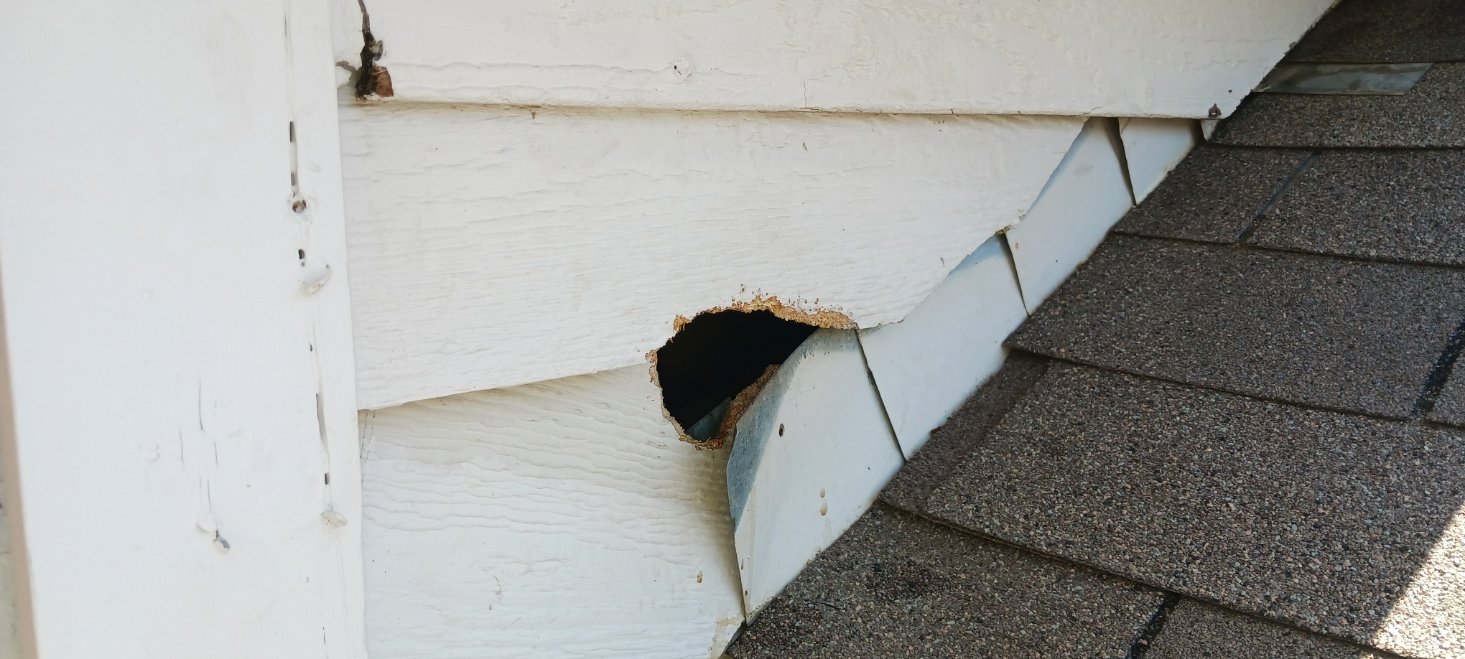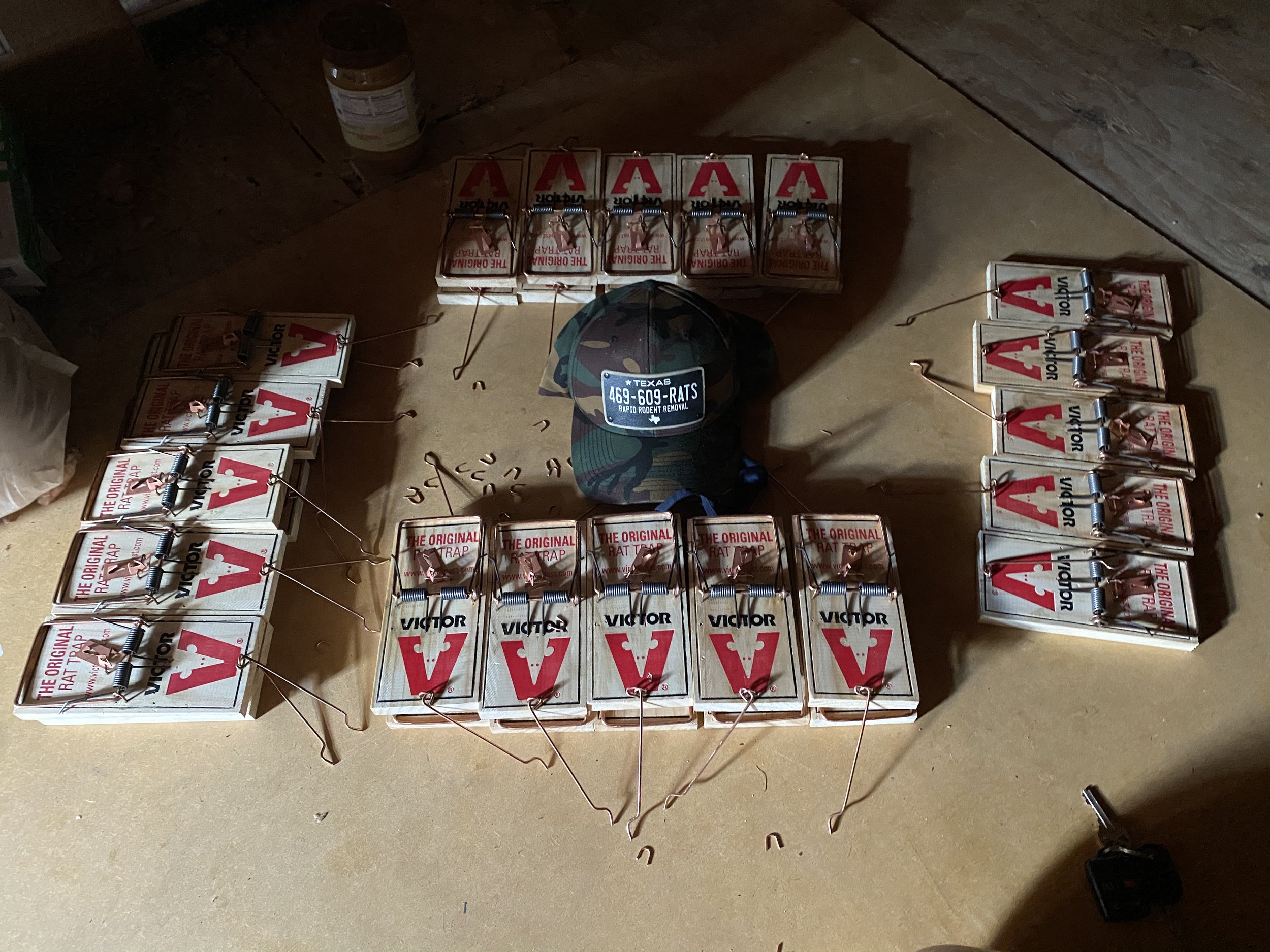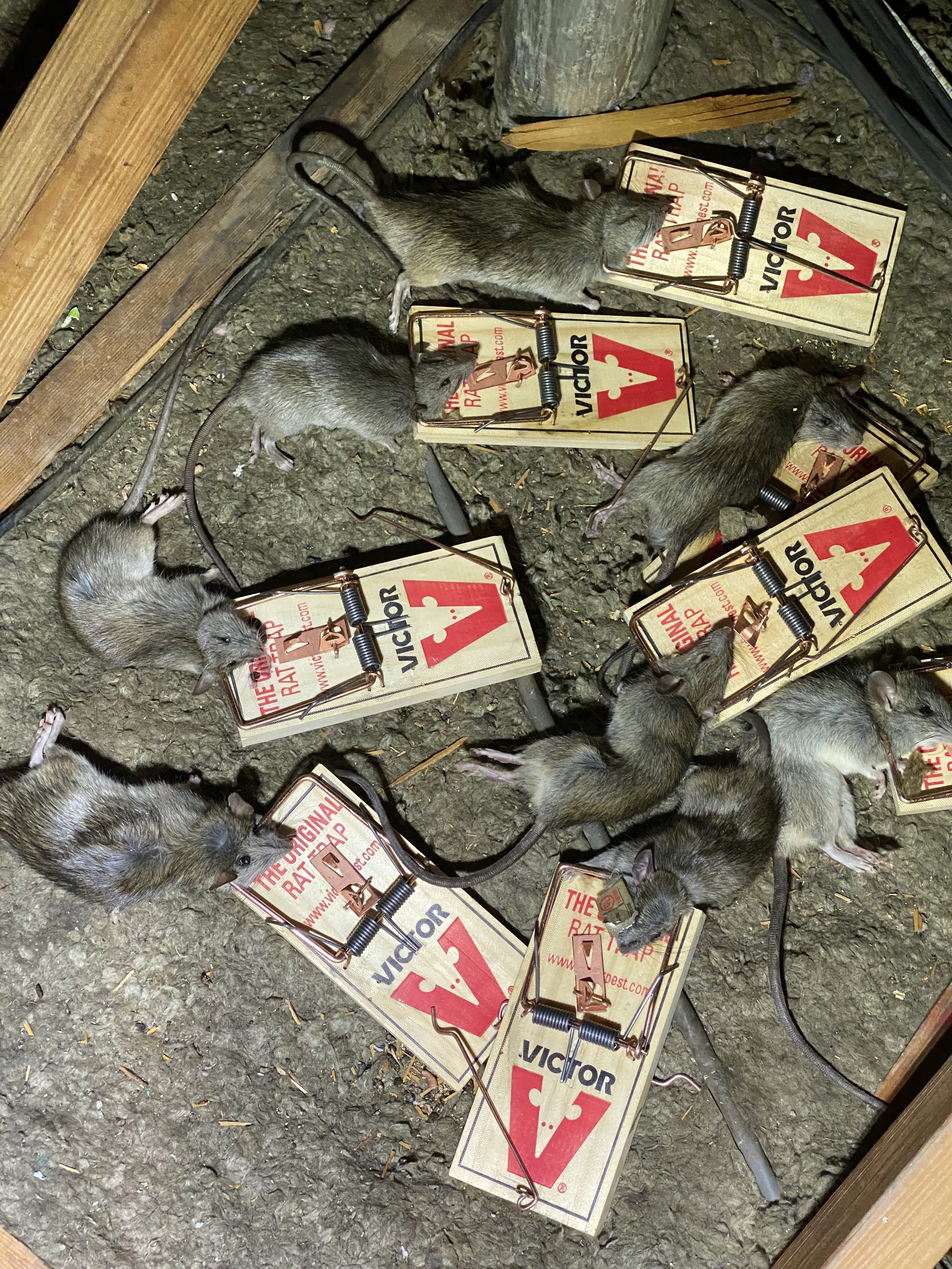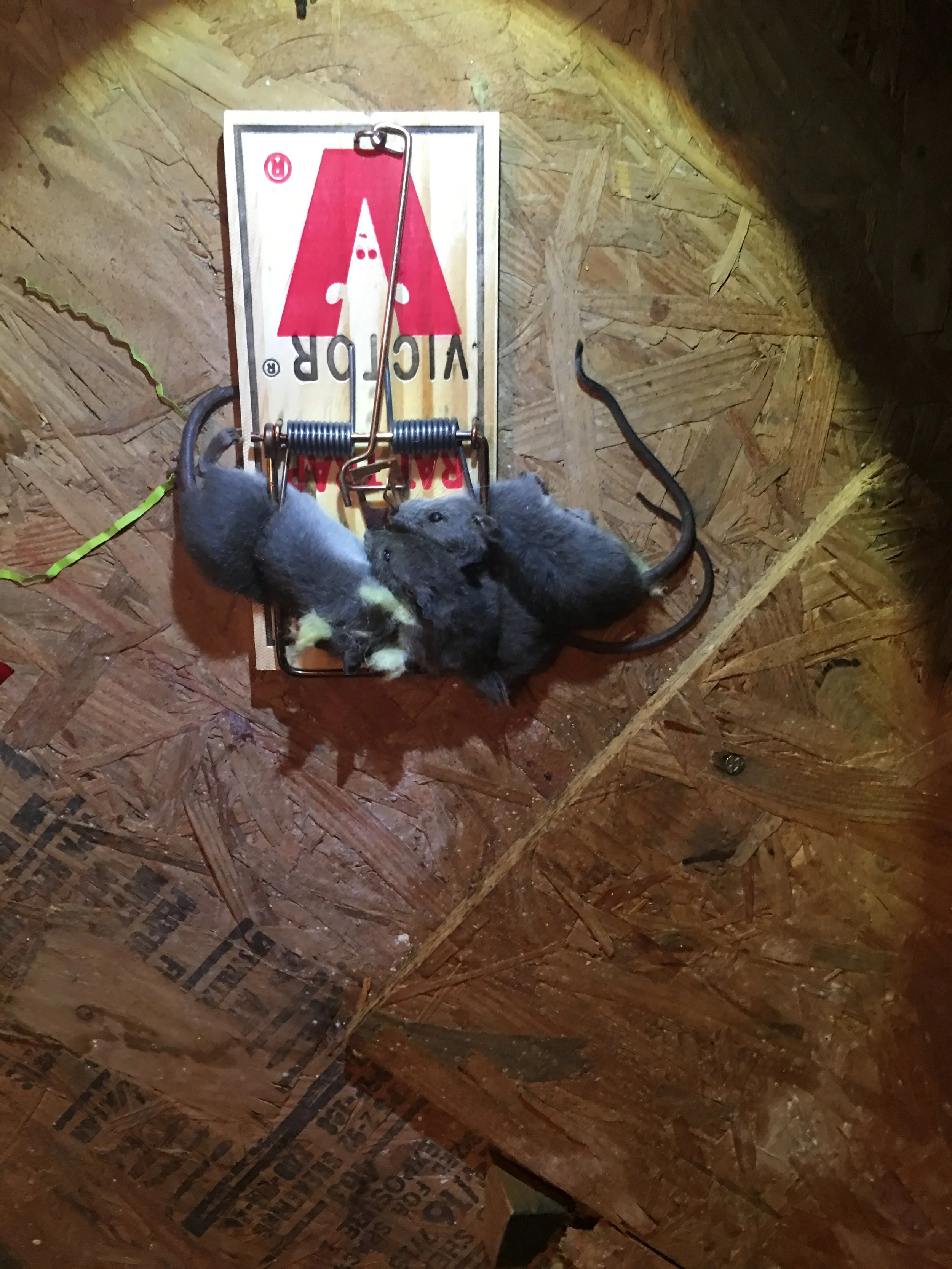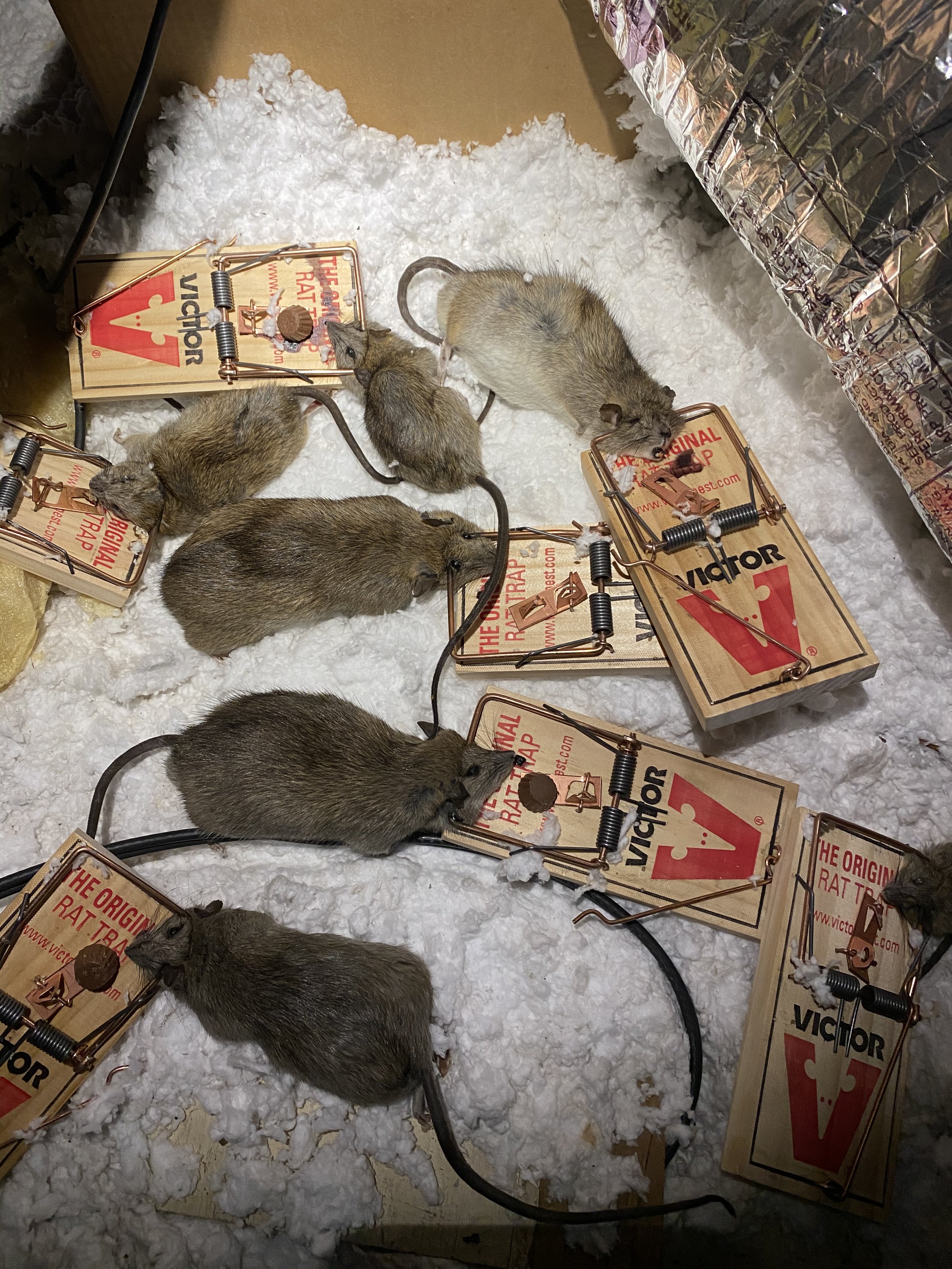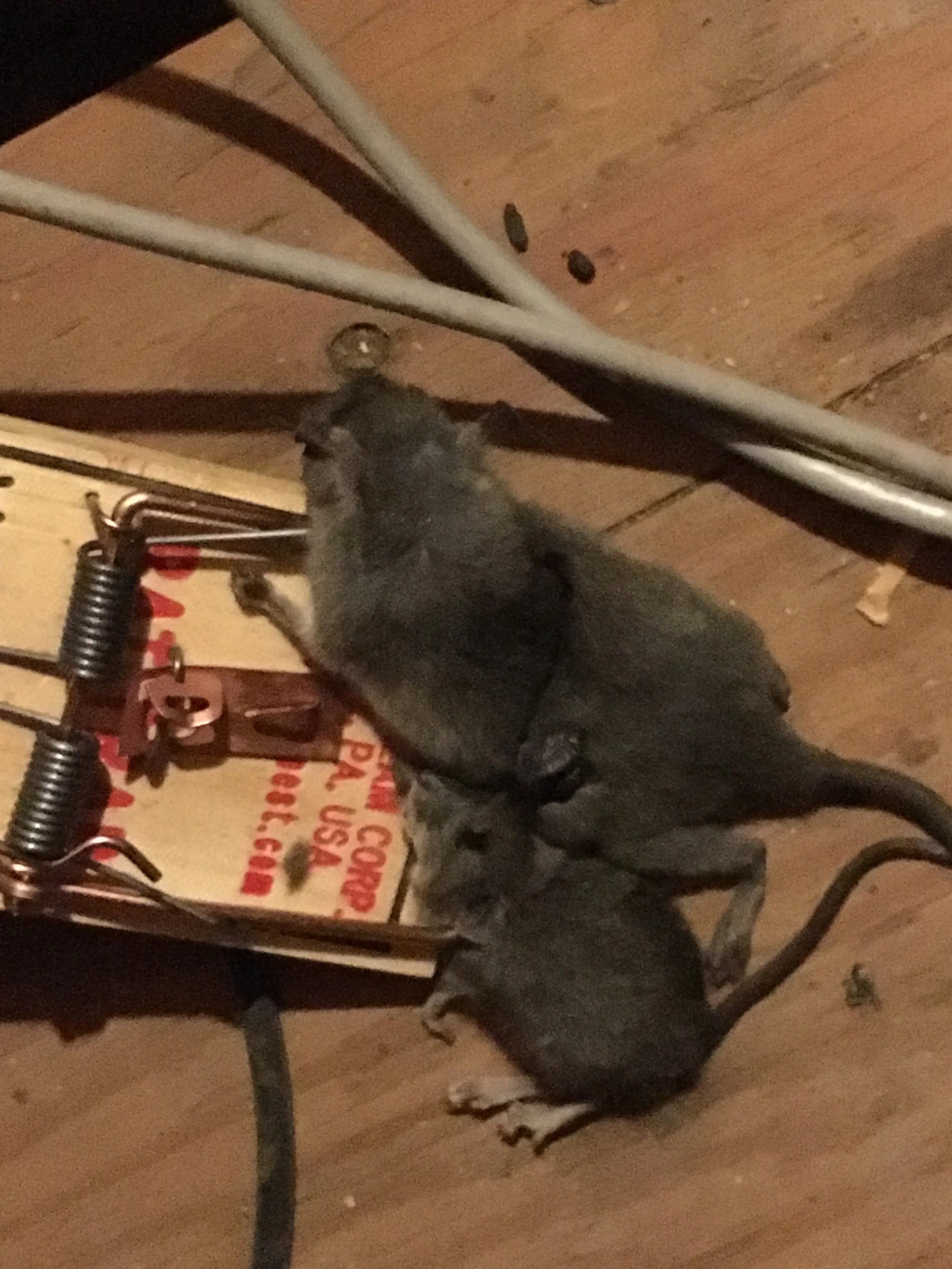Best methods to eliminate and dispose of rats properly
Table of Contents
There are two things at the root of all rodent control problems, if you control those you will control any animal in attic problem, and your need for rodent removal will be a thing of the past. Those two things are food and access. Now, to get rid of the rats in my attic, you are going to have to use traps ( best bait for mouse traps ) and in some cases bait stations to eliminate or kill the rats and prevent the mice / rodent or rat infestation and make sure, you will also have to seal any entry points to prevent future infestations.
The different types of rats most common in the U.S.A, particularly the rats in attic Dallas Texas are the Norway Rat and the Roof Rat. Below will explain how and where to inspect while you attempt to re establish rodent control the eliminate your rat population problem, or really any animal in the attic problem. Read more about how to tell the difference between Rat vs Mouse
It doesn’t matter if you saw a live or dead rat in your kitchen, found rat poop in your pantry, or mouse poop in your garage it doesn’t belong there, the unfortunate part is rats or mice don’t appear by magic, in a cloud of smoke. Rats either find a hole or make a hole, then they make a home (rat nest). EVERYONE KNOWS RATS PRODUCE FAST, its not uncommon knowledge. Regardless of the way you got to the conclusion you have rats the big question is how do we make it stop ?
We would be liars if we said it took a rocket scientist degree to eliminate rodents, it doesnt, its both really simple, and alot of hard work. The simple answer is below, and all the details involved in that process follow after that.
Removing/Eliminating Rats in the Attic in 5 easy steps:
1. Seal Any Big or Small Holes from Rats & set Traps
2. Keep Firewood and Piles of Debris Far from Your House
3. Trim Trees and remove climbing acesss from your home
4. Dont feed pets outside (they can smell it if its not there)
5. Protect your Garbage from rats
6. Trap and bait for rodents
7. Cleaning up after rodents
If you are interested in getting further into the details of the rats plaguing you below are several supporting articles to bring you closer to determining what exactly is going on.
One of the first indicators of the presence of rats is their droppings. A rat infestation in house can be determined or eliminated by a careful examination in dark corners and along baseboards for rat feces.
Rat droppings can be anywhere between a half inch to three quarter inches in size (contrasted against the rice grain sized feces of the house mouse) depending on which species is involved. The black rat’s fecal pellets are roughly a half inch long; those of the brown rat are larger commensurate with their greater size, each pellet can be ¾ of an inch long.
When fresh, rat feces of both species have a slight sheen and dark color. Also depending on the species of rats involved, droppings may be found singly or in groupings. As droppings age, they turn grey in color and have a crumbly consistency.
There are several reasons why it is important to get rid of rats in your attic:
Health risks: Rats can carry diseases that can be transmitted to humans through their urine, feces, and bites. These diseases include hantavirus, salmonella, and leptospirosis.
Property damage: Rats can chew on electrical wires, pipes, and insulation, causing damage to your home and potentially starting a fire. They can also chew through wood and drywall, creating holes and openings in your walls.
Noise and odor: Rats can be noisy, especially at night when they are most active. They may also leave behind an unpleasant odor.
Psychological impact: The presence of rats in your home can be stressful and unsettling, especially if you see or hear them regularly.
In summary, it is important to get rid of rats in your attic because they pose a risk to your health, can cause damage to your property, and can be a source of noise and odor.
The three most important steps for Rat Removal is :
Inspection
Exclusion
Trapping
Sanitation
Inspections an important first step in getting rid of rats. Once you know the location of the rats, you can set traps or place bait, we recommend checking the entire property and not just the attic , click here for signs you have a rodent infestation, if your unsure in the matter. The amount of rats in your attic doesnt matter consequentially, the more rats you have the more rat traps you should set.
is an important rodent control technique. It will get rid of the rats by making it difficult for them to enter the home or structure. Rats holes are easier to exclude than mice because rats a typically larger. Mice can enter an opening as small as 3/8" wide. All openings greater that 1/4" should be sealed to exclude mice. For rats, all openings greater that 1/2" should be sealed.
There are a few reasons why trapping rats may be preferred over using poison:
Poison can be harmful to other animals: If you use poison to kill rats, there is a risk that other animals, such as pets or birds of prey, could come into contact with the poison and be affected.
Poison can be harmful to humans: If you use poison to kill rats, there is a risk that humans could come into contact with the poison, either by accidentally ingesting it or by coming into contact with a dead rat that has been poisoned.
Trapping allows for more control: When you use poison to kill rats, you have less control over where the rats will die and how they will be disposed of. Trapping allows you to remove the rats from your property and dispose of them in a way that is safe and sanitary.
In summary, trapping rats may be preferred over using poison because it is safer for humans and other animals, allows for safe removal of the rats, and provides more control over the situation
Look for tracks and other signs showing rat trapping activity, like rat poop before setting traps, this will help determine where the rats are most active. Rat droppings are one of the main signs to look for, set plenty of traps close to where the rats normally roam. Place them along the paths the rats take through your attic. While the rats are active, they will stumble upon the traps and eventually end up in them. Try positioning a few traps near openings in the wall, close to where you see tracks or droppings, and behind furniture
For a better chance at catching the rats, set up lots of traps. If you’re only dealing with a handful of rats, you could set out a dozen traps. If you’re dealing with an infestation, set out up to 3 dozen traps.
Snap traps are ideal since they are effective and reusable. Position them so they are perpendicular to the wall. Rats often stick close to walls and will have to step on the traps as they scurry around.
Rats are most attracted to high protein, high carb foods. When trapping rats use common baits like peanut butter, hazelnut spread, meat/bacon, dog food, dried fruits, or cereal, chemical gels often dont work.
Snap traps should be placed perpendicular to the wall near signs of rodent activity
Please also read the section on Sanitation, as it is an important consideration in rodent control. Rat populations, continue to rise, this is no mystery, they were here first. Even the urban areas. They were once thought to be carriers of disease, historically they have been associated with bubonic plague, despite them not transmitting the disease. The creatures are instead the means by which the fleas that carry the plague pathogen are exposed to humans. These creatures are drawn to dense population where they can easily to establish places for feeding and nesting.
Rats do spread other diseases which put human health and safety at risk. We have written about that and it can be found here. Rat infestations happen, frequently, and the first impulse is to kill the rats or find someone who will. For those that feel that way we have listed many options for rodent control below.
Rat Control Methods we dont reccomend
Animal rights advocates recommend attempting to live in harmony with rat species whenever possible.
This is accomplished by rat-proofing a property to make it less attractive to rodents on the theory that “the prevention of a problem is always the cheapest and most effective way of dealing with rat control”.
When animals must be removed from an already infested property animal rights activists suggest the use of non-lethal traps. These traps capture the animals alive and unharmed and must be immediately followed by the release of the rats outdoors. Release does not mean dumping the rats miles away from point of capture but rather within 100 yards of the original location. Rats released farther away than this are more likely to die or be killed due to their unfamiliarity with their surroundings.
• Cats & Snakes are natural predators of rodents; rat terriers were specifically bred over centuries to catch and kill rats. this the most natural way to totally get rid of these rodents.
• Electrocution traps: are a new tech inventions marketed as a “green” product to stop the use of rodenticides. These devices lure the animal to them and emit a electric shock.
• Blunt-force trauma: this method of dispatching a rat is most common with the use of glue traps.
• Shooting with a projectile: you laugh be we get the call a few times each year.
• Glue traps are or boards which have been sprayed with industrial strength adhesives. These devices capture rats and mice when they cross them. Death can take a very long time (usually dehydration, starvation), which is why many use trauma in this situation.
• Poison: although still used by many consumers and pest control companies, rat poison does not provide a quick or painless death. Whether anti-coagulant based or chemical, poisons can take up to a week to actually kill the animal during which time they will suffer horrendously. Say No to Poison. We do not use or recommend the use of poison.
However despite the varied opinion of poisons and glue traps are they are legal and viable means for extermination.
Animal rights advocates such as People for the Ethical Treatment of Animals (PETA) advocate means and methods which do not involve death. Killing rats according to these animal activists only removes the problem temporarily—get rid of one and another will inevitably and quickly take its place.
First and foremost, these groups stress the importance of controlling the problem before it begins by reducing the attractiveness of a location to rats. Making a house impervious to rats is the single most important action that a property owner can take to prevent rat infestations.
• Keeping living areas clean and free of easily accessible food and water sources. This means cleaning up food spills as they occur; storing food items in gnaw proof containers; keeping food preparation areas diligently free of grease and food debris; repairing leaks in water pipes and fixtures immediately on discovery and avoiding areas of standing water as much as possible in and around the house.
• Sealing off rat points of entry in buildings and homes. Rats are opportunistic and ingenious; they take advantages of cracks and crevices as small as a quarter to gain access to structures. Roof rats have also been observed using phone lines to gain entry via small openings in house eaves. Basements with wooden floors and openings in building foundations are other points of vulnerability.
• Do not feed pets outdoors or have food dishes permanently positioned outside the house. If there is no alternative to outside feeding, pick up dishes and food debris promptly and thoroughly after pets have finished eating. When storing pet (or human) food in sheds, garages or basements sturdy plastic, glass and metal containers must be used.
• Do not maintain a bird feeder near the house. The spillage from bird feeders is a huge attractant to rats. Either feed birds only in times of severe weather when they cannot forage for themselves or station feeders away from house, garage and other outbuildings.
• Keep grass cut and bushes at least 18 inches away from the outside of the house. This exposes points of available entry and makes it more difficult for rats to roam about unobserved. This action will also reveal burrows and nests near the house and should help with removing rats in backyards. Rats like most wild creatures avoid high exposure areas.
• Keep woodpiles away from the sides of homes and garages. Wood stacked against the side of a structure can allow rats to burrow into structures unseen or hide existing points of entry. This will pre-emptively eliminate the possibility of rats in walls by cutting off a prime avenue of access.
Ideally, these simple, effective measures result in natural population control by denying rats sustenance and shelter. Rats can and do live in areas of high human population density undetected and without creating significant public health hazards when these methods are assiduously employed.
So which type of rat do you have scurrying around in your attic?
To determine this, there are a few key differences you should note down. This is important in helping you catch and eradicate your rat problem, as each species will have preferred baits and methods for trapping.
Appearance - Roof rats look sleek and fast, whereas Norway rats look large and slow(er)
Color - Roof rats are more commonly Black whereas Norway rats are more of a brownish color
Tail - Roof rats have a long rail (longer than their overall body) whereas Norway rats have a shorter tail, shorter than their bodies.
Head/snout - Roof rats have more of a pointed snout, whereas the Norway rat has a blunt snout.
Norway rats, also known as brown rats, are larger than roof rats, they have fairly short tails, and they love to burrow. If these creatures are living in your attic, you’ll notice they have tried to burrow everywhere- look for shredded paper, insulation etc.
Dispose of Roof Rats after you kill them
Roof rats, also known as black rats, are mostly smaller than Norway rats- apart from their tails. You’ll know it’s a roof rat you’re dealing with if its tail is longer than its head and body combined. These rats are agile climbers, and will usually nest in shrubs above ground, so it makes sense that they will make their way up to your attic.
Rodent Urine is a sign you have rats
Other indications of the presence of rats are urine trails or puddles and “grease” stains on walls and baseboards. These stains are caused by the natural oils and dirt on the rats’ fur rubbing off on surfaces they travel on or through, small barely distinguishable stains are likely caused by mice, rats leave larger stains on these surfaces.
Rats are the poster children for incontinence; they dribble urine with almost every step they take and pass feces with a similar abandon. Rat urine leaves a musty scent, most noticeable in small enclosed spaces.
Rats are inveterate nibblers who can bite through all but metal, glass and thick plastic containers. Even if droppings are not readily apparent, if chew marks are found on food boxes or sacks, a rat or mouse infestation is all but a certainty. Dry pet food bags or boxes should be inspected as well; rats are particularly drawn to “meaty” smells characteristic of both cat and dog chow.Good starting points in a survey for signs of rat infestation are the areas involved in food storage and preparation. Rats exploit human populations for ready food and water sources, the pantry or kitchen is a magnet for rat activity. Droppings and grease stains may be visible in kitchen cabinets and drawers; but food containers should also be inspected for signs of gnawing.
Rats have been known to gnaw into non-food items such as soap. If an item has a smell attractive to the rodents, they will nibble away on it.
Another kitchen location for rat sign is under the sink. If plumbing is at all leaky, the opportunistic rodents will avail themselves of the ready water supply. They have also been known to chew through plastic water pipes. This extends to other plumbing, including the bathroom and laundry rooms. Carefully inspect the areas around any pipes or faucets for droppings urine, grease marks and signs of chewing.
Rats have incisors that never stop growing; they gnaw on non-edible materials to wear the teeth down. Wood is a favorite target of rat gnawing. Sometimes teeth marks are readily apparent on exposed wooden surfaces; the newer areas will be light in color, revealing the untreated wood beneath the surface. As these marks age they darken, so that new markings can be readily distinguished from old. Even when obvious gnaw marks are not visible, sawdust and small chunks of wood near baseboards may indicate the presence of a rat colony.
Another, often overlooked sign of a rat infestation is rat sounds. Rats are nocturnal animals that tend to be the busiest while humans are asleep. Nevertheless, the alert homeowner will be able to hear squeaks, scratching, rustling and scampering sounds as the rats travel about in search of food and build their nests. Listening for these sounds just before bedtime can help to verify a rat problem.
Rats nest in warm, dry, out of the way places including boxes, inside cabinets, behind dressers (and in drawers, especially those not often accessed), even the casings of computer towers. They will also climb up into the insides of furniture to nest in the stuffing.
Rats also take advantage of the warmth found near refrigerators, stoves and dishwashers, hiding behind or even inside of their housings.
Rats prefer soft, warm and fuzzy nesting materials, which they transport to the nest site and stuff into their chosen space. Nesting materials include grasses, fabric, furniture stuffing, quilt batting, absorbent cotton, shredded paper and twigs. Inspect stored fabrics for chew holes, quilt and cotton batting for any sign of urine and droppings, whenever possible store such inviting nesting materials in durable plastic storage containers that can be sealed airtight.
The presence of rats can generate greater excitability among household pets. If your dog or cat spends time listening intently or pawing at baseboards and walls, it is highly likely that they are responding to the activity of rats within the structures. They also respond to the odor of unseen rodents, although they may alert to old rat smells as well as more recent ones.
In dusty areas, rat paw prints may be visible along baseboards and walls. Where dust is not allowed to accumulate, one can test for the presence of mice and rats by sprinkling talcum powder next to baseboards, leaving it for a few days. If rats or mice are traveling along these paths, the talcum will bear evidence of their habitual traffic.
Incidentally, inspection for rat infestation signs should not be limited to interior spaces alone. Food gardens or nearby agricultural fields are strong rat attractions. Plants and their fruits should be inspected for signs of chewing, and the surrounding soil checked for evidence of rat droppings. Outside structures used for grain storage should be regularly inspected for evidence of rats as well.
Rats present health risks other than direct transmission of diseases. Their urine and fecal pellets can contaminate food and water supplies rendering them inedible and undrinkable. Rats also have mites and fleas that can readily jump to domesticated pets, and in some cases, onto people.Rats are perceived in most of the world as dirty animals that spread disease to humans and domesticated animals. It is true that a number of serious diseases and illnesses are transmissible from rodent to human or pets. Companion animals can fall victim to some of these diseases, other maladies use cats and dogs as vectors to spread to humans.
However, the risks of rat infestation are not just to health alone. The tendency of rats (and mice) to chew on electrical wiring is claimed to be a common cause of structural fires. Rats are not inconsiderable sources of structural damage.
Rats not only gnaw to wear down their incisors, they will also chew through walls and other impediments to reach food, or to create a more direct route to a water or food source. They may also chew into structures to expand or create nesting sites. Rats can cause substantial damage to walls, baseboards, roof rafters, subflooring, ceilings and support beams, especially when a large colony of rats is responsible for the infestation.
Let’s say you’ve done your due diligence and have determined that your home or business has been infested by rats. What do you do?
The first thing NOT to do is panic.
The second thing to do is determine whether or not it is necessary to hire a professional to deal with the problem or fight it yourself. This decision is not always a simple one; the size of the infestation is a consideration. If the rat population invading your structure is small, do-it-yourself efforts may be successful both in terms of cost and efficacy.
If the infestation is severe or you simply don’t feel you can cope with the elimination of the rats, you should consider enlisting the services of a professional rat control company. Money spent on experts can often turn out to be more cost effective in terms of greater efficiency and reduced costs of traps, poisons and cages. In individual stress alone it may well be worth it to leave dealing with the infestation in the hands of qualified technicians.
Exterminators can also often help home and business owners rat proof their buildings after the infestation has been dealt with. They frequently also provide ongoing monitoring against future invasions.
There are other considerations which impact the decision of hiring rat control specialists or going the DIY route. You must determine if you are willing to solve your rat problem via toxic, inhumane efforts, or if you prefer humane, environmentally friendly and pet safe alternatives.
Rat poisons are not only considered inhumane due to the length of time it takes rat poison to effect a kill; they present significant risks to the health of pets, wildlife and young children via secondary poisoning.
The U.S. Government has recently limited access to certain types of rat poisons and has banned others outright. Consumers are no longer allowed to buy certain rodenticides, and regulations have been implemented that limit the types and designs of rat traps that can be used by the public. Poisonous baits must now be housed in tamper proof bait stations that limit the access of wildlife, pets and children to the rat poisons contained within.
Poisons can also leach into soil and water putting other animals and humans at risk. Also, rats dying of poisoning often retreat to their nests, which means that dead rodents will decompose in areas inaccessible to humans. This can lead to long lasting, very unpleasant odors within a home or business.
Thanks to the societal “Green Revolution” many rat control specialists are now turning to extermination and control methods which are considered more environmentally friendly, humane as well as less toxic to non-target animals. Careful research into the types of exterminators found in your area, and the methods employed is vital.
Rats breed and colony size increases when the supply of food and water is steady and abundant in quantity. In order to prevent future infestations follow these guidelines:In terms of rat control an ounce of prevention is worth more than a pound of cure. After an infestation has been dealt with—or better yet, before it establishes itself– the key to a permanent solution to rat infestations is to make a property less attractive to rats. This requires a certain amount of effort and dedication to ongoing maintenance on the part of the property owner but the labor expended is well worth it.
• Rat proof your house by closing off areas of easy access, including small gaps in foundations, roofs and rafter areas. Cover up ventilation openings with rat proof, high strength mesh. Fix or block other non-essential openings in walls, roofs and foundations. if you fix a hole set a trap.
• Remove or trim back shrubs and plants that hug the sides of buildings. Rats, depending on the species use these as either a ladder to climb up into a structure or camouflage for burrowing near or into a home or business. Keep lawns closely mowed within 18 inches of the outside walls of structures. Remove woodpiles and debris from yards or move them farther from existing buildings.
• Either police your bird feeder and diligently clean up any spillage or locate the feeders away from the house. Seed spillage from feeders is one of the prime attractants for rodents.
• Do not feed pets outside of the house, or if you must, monitor the feedings personally and remove any leftover food from the exterior feeding area. Rats love to pillage pet food dishes and water bowls which can also attract other animals like opossums that are also capable of spreading disease to humans.
• Do not store pet food in sheds or garages unless you are able to do so in containers that a rat cannot chew through. This means metal, glass, ceramic or heavy duty plastic containers with airtight seals only.
• Keep indoor areas clean and free of food and water sources. Clean up food spills immediately and thoroughly. Store food items in chew-proof containers. Keep food preparation areas free of grease; use weak water and bleach solution to sanitize counter tops and other areas where food is handled or sits for even small periods of time.
• Repair leaky pipes and faucets immediately, avoid areas of standing water inside and adjacent to the house.
• Keep homes free of clutter, especially of materials attractive to nest building females. Dispose of paper refuse; keep garbage bins/containers clean and tightly closed between trash pick-ups.
Eliminating the avenues of access for rats forces them to rely on other sources of sustenance and water. Populations will self-control according to natural food sources in the wild. In lean times, rat populations will not increase but decrease; starvation is a natural population control. Females will not breed readily where the amount of available food is unstable or scarce.
With just a little effort, as wells as small investments of time and attention rat infestations can be eliminated in your home.
Best Practices
You need to seal each exterior hole into your house. This can be anything from a crack in the foundation to a loose roof tile, open chimney or trashcan. Mice, insects and bats can also exploit these holes, so sealing them up can solve many pest problems.
Rats have exceptionally strong teeth and can chew through roof tiles, vents and soffit covers. Any existing holes should be sealed with steel mesh or concrete. Ensure outdoor trashcans are not left open and remove debris and loose vegetation from around your home as it can harbor the insects rats love to eat.
Hawk or owl decoys and live cats also do not properly repel rats. Ultrasonic emitters are marketed as producing a high-pitched sound that will annoy rats into leaving, but these are also pointless. The only way to prevent rats from entering your home is to seal it up and deny them entry.
Rats can be incredibly invasive, and it only takes one to contaminate your home. Minimize your stress by using a professional to remove rats and any other unwelcome pests.
First, try to identify how the rats are getting into your attic. Look for holes or openings in the roof, walls, or foundation, and seal them with wire mesh or other materials to block the rats' access.
Next, remove any sources of food and water that may be attracting the rats. Keep trash cans securely covered, store food in airtight containers, and repair any leaks or plumbing issues that may be providing water for the rats.
Use traps or bait stations to catch and kill the rats. There are several types of traps available, including snap traps, glue traps, and live traps. Bait stations are a good option if you want to avoid handling the traps directly.
Consider using a rodent-proofing service or hiring a pest control professional to help with the removal process. These experts have the knowledge and equipment to effectively eliminate the rats and prevent future infestations.
Regularly inspect your attic and property to ensure that there are no new rat intrusions.
Remember to handle any trapped rats with caution, as they can carry diseases and may try to bite if they feel threatened. It is also important to follow all safety instructions and local regulations when using traps or bait stations.
In an attempt to remind customers that Rapid Rodent Removal are also roofers, we have also made a table of contents with all of our information about rats , mouse , squirrels and Roofing , Roof Repair , Roof Replacement (articles & blog) stemming from to all about Rat poop , Mouse poop , Squirrel poop or Raccoon poop in Your Home & or Rats in Attic, to Roofing Contractors to Rodent Control.




